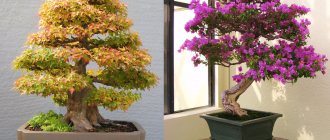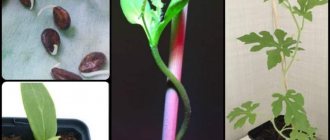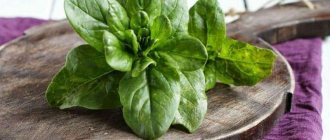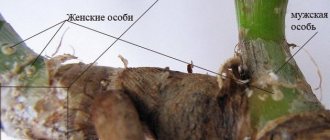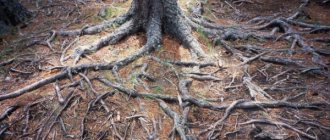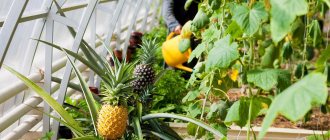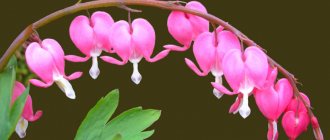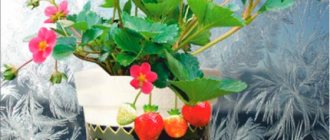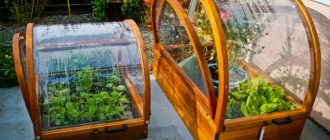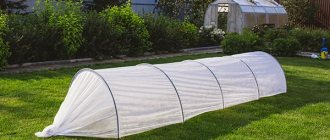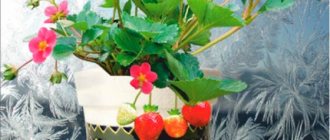Bonsai is a gardening art whose purpose is to grow a decorative miniature tree. Imagine pine, cedar or maple growing in a small pot on the windowsill!
The hundred year old maple and scarlet begonias look amazing!
This art appeared in Japan more than 2 thousand years ago, then migrated to China, and about a century ago it became popular throughout the world. Let's talk about how to grow bonsai, how to choose a plant, soil, pot, how to form a crown, etc.
How to grow a bonsai tree
Bonsai is not just a gardening technique, it is an entire Eastern philosophy. It develops patience and is great for relaxation and contemplation. Caring for bonsai can be compared to meditation, when a person is completely immersed in his activity. Bonsai can be with you until the end of your days. In fact, the ancient Chinese believed that those who could care for a miniature tree for a long time had eternity granted to their soul. For them, a tree can be a connection between a saint and a person, between heaven and earth.
The first records of people growing bonsai were found in China. Contrary to popular belief, bonsai trees are not genetically dwarf plants. They are kept miniature due to special growing conditions. You can grow a bonsai tree with your own hands at home, the main thing is to know how to do it correctly.
How many years does a tree live?
In their natural environment, trees can live for several centuries. However, bonsai have not existed in apartments for more than 15 years. Therefore, it is necessary to come to terms with the periodic aging of the tree and its devastation from the inside. Gradually, cavities appear under the bark, and the tree withers. However, there are many cases where a bonsai lived for about 25 years in an apartment.
Thus, if you want to grow bonsai at home, you can choose one of many crops. The cost is quite affordable, but it is more profitable to purchase seeds. Then you can decide for yourself what the tree will look like by periodically pruning it. If there is no desire or opportunity to prune the tree, then you should not grow this crop. Otherwise, you will have to spend a lot on feeding, and the plant itself will have a strange appearance.
5/5 — (1 vote)
How to choose a tree type
Growing bonsai at home begins with choosing a tree. There are several options suitable for beginner bonsaiists. These are Chinese elm and Japanese black pine. Any tree can be a bonsai. Many people prefer species with small leaves; they are easier to model. There are other considerations that need to be taken into account when planning your miniature. You can start from scratch, which means buying seeds from a store or collecting them near your home or in the wild.
To determine which tree to grow bonsai from, you should understand what is more important to the gardener: foliage or needles, flowering and fruiting, and the unpretentiousness of the plant. Flowering bonsai can be obtained from many crops (azaleas, apple trees, cotoneasters, cherries, citrus fruits, camellias, gardenias). If your bonsai trees are deciduous, their leaves will change color and fall off with the seasons.
You can find a stock plant, called by professionals “prebonsai” (rooted sapling). This makes the process faster, although growing bonsai is a good exercise for training patience. The last option may be the simplest and least educational - buying a mature bonsai. The owner will only need to take care of it and perform timely maintenance.
More on the topic:
How to Grow a Money Tree Bonsai
More on the topic:
All about bonsai at home
Choosing a seedling for bonsai
The types of bonsai trees depend on the environment in which it will be grown. The climate and furnishings of the home must be taken into account. Beginners should prefer plants that grow in their region.
- Deciduous species (Chinese or Japanese elms, magnolias, oaks and apple trees) are good choices for outdoor growing.
- An excellent choice of conifers are juniper, pine, spruce or cedar.
- If you want to grow a miniature indoors (or if you live in a hot climate), consider a tropical variety. Jade, snow and olive trees can be grown as a miniature garden.
Choosing a seedling in nature
If you like the option of digging up a seedling in a forested area, pay attention to a number of factors:
- Choose a sprout with a strong trunk, but still young. Old plants do not adapt well to new conditions.
- The sprout should have roots evenly distributed in all directions.
- Dig around and remove a large amount of soil along with the roots. This will prevent the plant from dying from impacts during transportation.
- Plant the dug up seedling in a “training” container.
Wait about a year for the roots to get used to the container before transplanting it into a special container.
Buying bonsai in a store
This is the easiest and most expensive way to start growing live miniatures. Bonsais that have been grown from seed have already received a lot of time and care from their creators, which is why they are expensive. If you buy a ready-made bonsai from a store, talk to someone who knows its history and characteristics. When you bring him home, give him a few weeks to adjust to his new surroundings. Growing bonsai from seed is considered traditional for the classical Japanese school.
As Japanese wisdom says: the art of Bonsai is not a race, it is an endless journey.
Techniques (methods) for growing them
Next, we decide on the start. There are three techniques for growing bonsai trees:
- from seeds (it will take 12-15 years to form a bonsai-like plant);
- from seedlings (minimum period - 5-7 years);
- cuttings (some species will look like bonsai after 4-5 years).
Advice for beginners: form one or two seedlings, and grow another ten, twenty or thirty.
With any growing method, the plant in the “starter” pot is grown to the desired height. The formation of the crown and bending of the trunk occurs while the “blank” is growing. A ready-made mini-tree that has finished growing is transferred to an “adult” pot.
What to do with the seeds
If you decide to germinate from seeds, place them in a container with moss for the cold season and place them on the bottom shelf in the refrigerator. Until spring. Cold temperatures prepare the seed to grow as the weather warms. This process is called stratification. In the spring, plant the seeds in the ground, keep the soil slightly moist, but do not let it sour. Sprouts will quickly appear and immediately begin to grow.
Seeds can be germinated in egg trays
Stratification is necessary for plants in our climate zone. Germinate tropical tree seeds after soaking them in water for 24 hours.
The hatched seeds are watered and left to grow. When they are more than 10 cm high, you can transfer each one to its own pot, wait a couple of months until they take root, and begin formation.
Choosing seedlings
Grow a bonsai from a seedling faster. They are planted in the fall. It will be much easier if you buy a selected and prepared plant in a specialized store or garden center.
In general, seedlings can be found in the forest, but it is better on a roof, on a rock or a fence. Where there is not enough soil. The plant should be no more than 15-20 cm high. It is desirable that it already has enough lateral branches.
Seedlings can be bought at a specialty store or found in the forest. To make it clearer what to choose, the right one at the plate is simply perfect. Cut off the excess during the formation process and get a decorative crown
If you dig, grab some of the “native” soil - adaptation will be easier. Allow the plant to take root in the pot until spring.
Bonsai cuttings
You will have to take cuttings for exotic plants such as ficus, figs, tea tree, etc. They are cut off in the spring from mature plants (before young buds appear) from the trunk itself. The length of the cutting is about 25 cm. Ideally, there should be several side branches. We cut off the upper, too soft part of the cutting parallel to the ground. We also cut off the lower one, which is too hard, but at an angle. We remove the lower leaves; if there are large ones, cut off most of them, leaving half a leaf.
Cuttings must be strong
Dip the bottom cut into the rooting agent.
Phytoclon - an effective gel for rooting plant cuttings
The cuttings can be kept in water until roots appear or immediately planted in a clay pot (regular) with ordinary garden soil. The cut should be deepened by 5-7 cm. Place the pot/jar with cuttings in the shade and water regularly. When new leaves appear, gradually move the pot to a more illuminated place, but not into open sun. Feed once a month. Grow the seedling for a year or two until it reaches the desired height.
Bonsai pot
Choosing the right bonsai pot is not easy. In professional literature they are called bowls. This dish has a unique shape and does not look like the usual pot for indoor plants.
These containers are manufactured in factories, or can be made to order by a potter based on an individual project. The second option has a very high cost, but is an exclusive product.
A distinctive feature of bonsai trees is that they are planted in pots that limit root growth.
The most important factor when deciding which pot to use is to make sure the pot is large enough for the soil to cover the plant's roots. To prevent root rot, you should also make sure your pot has one or more drainage holes in the bottom. If not, you can drill them yourself.
Selecting sizes
The first criterion for a pot is the size of the bowl. The pot must be large enough. You must maintain the aesthetics of your miniature. Pots that are too large can spoil the appearance of the bonsai, creating an odd appearance. Some people grow their arrangement in simple pots and then move them to nicer ones. This is useful if your plant is still fragile. The depth should be equal to the diameter of the bonsai trunk.
- For oval or rectangular shapes, the length should be 2/3 of the height of the tree.
- For round ones, the diameter should be 1/3 of the height.
- Miniatures with a wide crown may require a wider bowl.
- Specimens with a thick trunk require a deeper container.
These recommendations are based on aesthetics. Some types of trees require larger or smaller pots. Trees with fast-growing roots need deeper containers.
Thumbnail style
Rectangular or oval shapes are used for vertical and slanted trees. Literatures are placed in small round pots. For cascading compositions, a deep round, square, hexagonal or octagonal shape is used. The gallery below contains photos of a wide variety of bonsai pot options.
Special Representatives
This type of gardening has a long history. Its homeland is China and India. Bonsai appeared in Japan in the 6th century, and this art was brought by wandering monks. Gradually, 15 styles were developed that made it possible to turn trees into beautiful miniatures.
Real masters perceive the technique of creating bonsai as an opportunity to create something unique and highlight the beauty of nature. They can be grown not only from indoor plants, but also from garden plants.
Not everyone can master the art of creating dwarf compositions
Important! Before creating a composition, a person must have a good idea of the end result.
Bonsai is an art that requires a special approach. The trunk and branches create a special charm that brings the miniature to life. The tree is subject to strict quality requirements.
Japanese culture
In the Land of the Rising Sun, bonsai became popular during the Tokugawa era. Then rich people sought to create beautiful parks, and monks - gardens. Buddha's followers believed that through plants they created new worlds.
Therefore, by growing bonsai, a person connected with God or became rich. In Japan, such trees are in great demand. Pots with them are placed in rooms and in the garden.
Tourists do not always understand what real bonsai is in Japan. In the Land of the Rising Sun, this is a real art, which can only be mastered by real masters. In cities, such dwarf trees allow you to preserve a piece of nature in miniature apartments.
The most expensive copy
Bonsai is a Japanese art, but it is only available to rich people. You have to spend a lot of time on each copy. The record in this area belongs to a tree that was sold at auction for $1.3 million.
Note! Outdoor bonsai dates back several hundred years. During this time, its trunk bent bizarrely, and its crown branched beautifully.
Old bonsai tree
In addition to bonsai, which is the most expensive, there are also specimens that are distinguished by their impressive age. The record holder in this field is already 800 years old. The trunk is very thick and wonderfully intertwined, and the crown spreads beautifully.
Among dwarf trees there are also unusual representatives. One master was able to grow wisteria, which blooms beautifully. Another person not only grew a wonderful bonsai, but also created a composition for it in the form of a Hobbit house.
One of the most famous masters who creates outdoor bonsai is M. Kimura.
An example of a composition by a famous author
The word “bonsai” is translated from Japanese as “grown in a tray.” In the Land of the Rising Sun, dwarf trees are grown for apartments. Due to their flat root system, they need wide, low pots. The pallet also becomes part of the composition.
It is not necessary to know how the word “bonsai” is translated. It is important to understand how to create a composition and what to consider.
How to place a bonsai
The miniature in an oval or rectangular container should be placed slightly behind the center line of the container. Depending on the shape of the tree, it should be slightly left or right of center.
Plants with a long first branch going to the right should be planted slightly to the left. This gives a "picture" balance. If the first branch grows to the left, then the tree is planted to the right of the center of the container.
The exception to the rule is square and round bowls. In them the composition is placed in the center. This also applies to cascading miniatures. In this case, the root system does not always allow such positioning.
Should there be glaze on the pots?
- Unglazed examples are earthy in color, ranging from light brown to dark brown, rusty brown to red-brown.
- Earthy colors are suitable for coniferous and dense deciduous compositions. The dense greens or blue-green foliage of conifers tend to pair well with shades of brown.
- Glazed ones can have different colors. It is important to make sure that the icing inside is no more than a third of the way deep. The color of the glaze is selected and complements one of the colors of the main elements or features of your bonsai. This can be the color of leaves, bark, fruits.
Advantages of decorative trees in the interior
The oriental style of the interior is restrained and calm. But even in such a minimalist design there is always a place for indoor plants. Japanese bonsai is a popular floristry trend that will fit perfectly into any room. Natural decor will look original in a classic living room or in a modern high-tech kitchen.
So that the bonsai does not look lonely and does not stand out as a green spot against the general background, you can place other plants in the room that are similar in the shape of the trunk or crown. Wall paintings with natural motifs will perfectly complement the interior.
Natural decorative trees of any size are simply created for rooms decorated with natural materials. Stone tiles, wooden lining, and massive furniture go well with Japanese wood. If the crown has a bright color, you can highlight it with the help of window textiles, pillows, and small accessories.
The main advantage of decorative trees in the interior is the ability to create a natural atmosphere. A miniature copy will become a central accent and will not go unnoticed upon entering the room. Thanks to the many styles, you can create an original decor to match your existing interior. Common bonsai options are “Classic straight”, “Tilted tree”, “Cascade”, “Two trunks”, “Roots on a rock”, “Rooted in a stone”.
Basic recommendations for choosing a bonsai pot
Bonsai pots are often compared to a painting frame by bonsai artists. They should emphasize the grace and aesthetics of the composition, frame, and not distract attention to themselves. The correct product must meet certain criteria. The condition and health of the composition depends on the quality of the container.
- The pot must be large so that the tree's roots can grow freely. The ends of the roots absorb moisture and nutrients. Therefore, they should have enough free space.
- Replanting a tree does not mean increasing the size of the container. If the bonsai has already been formed and regular pruning of the roots and crown is carried out, you can replant the plant in the same bowl, simply replacing the soil.
- The larger the pot, the less often the composition is watered.
- Ideally, the length of a bonsai should be approximately 2/3 of the height of the tree. If its height is shorter than its width, the length of the pot should be 2/3 of the width of the plant.
- The shape should match the bonsai style. For compositions with straight trunks, rectangular containers are better suited. Curved barrels look best in round, oval or rectangular bowls. It is better to plant a strong and powerful tree in a container with right angles.
Secrets of Ancient Japanese Art
To make a bonsai successful, you need to follow a number of recommendations and know the secrets of success:
- not every tree can embody a certain style;
- When starting out for the first time, it is better to choose simple, unpretentious flowers that are easy to care for. A bonsai flower that will delight you with lush blooms looks very beautiful and bright;
- Even if the unusual creation is purchased, it needs to be trimmed regularly, otherwise it will lose its shape.
Before you decide to start a bonsai, you need to accurately determine whether there will be enough time for it, because caring for it is a painstaking task that requires a lot of effort. But all the work will be fully rewarded with a beautiful and unusual creation.
*Prices are as of December 2022.
How to choose material
A good bonsai pot should have drainage holes and wiring holes so that your tree can be attached to the container. They are made from:
- ceramics;
- porcelain;
- concrete;
- clay;
- mica;
- metal;
- tree.
Metals can release toxins. The use of plastic containers does not correspond to the philosophy of bonsai and is considered bad manners among experienced craftsmen. A classic pot is made of porcelain or ceramics. These materials absorb moisture, which has a positive effect on plant health and drainage. A true Japanese bonsai only has clay pots. For especially valuable specimens, they are made to order and individual style.
Forming and laying technique
When we bought or grew a seedling, it’s time to start shaping and styling it. This is the creative part of growing bonsai and the most difficult. Pine bonsai, properly stylized, look especially impressive. While miniaturization techniques have taken a long time to perfect, some basics can be learned quite easily.
The most important technique for bonsai is pruning. It is necessary for miniaturization and structure formation. The goal is to create a unified look that is as close to nature as possible. Spring and summer are the best time to prune, but it depends on the type of plant. When pruning thick branches, a good concave knife is a must. The wounds left by these incisors heal much better than regular scissors. It is impossible to tell which branches need to be pruned to form a bonsai without seeing it. Some examples of when they should be removed:
- If two branches appear at the same height, leave one and prune the other.
- The branches have unnatural turns.
- Disproportionally thick branches at the tops.
Another important technique for shaping bonsai trees is wire. It is made from anodized aluminum or annealed copper. The wire is wrapped around the branches. This way they can be bent and shaped into the desired shape, at least to a certain extent. This technique can be used year-round, but be sure to remove the binding before it begins to scar the branches, which become thicker.
Plants that are suitable for growing in our environment:
- Common lilac, Hungarian lilac, White lilac, White variegated lilac;
- Spiraea japonica, Spiraea middle, Spiraea birch-leaved, Spiraea prostrate;
- Irga alder, European forsythia, common cherry, steppe cherry;
- Siberian spruce, prickly spruce, prickly gray spruce, globular willow, weeping willow, Ledebura willow;
- Berry apple tree, Sievers apple tree, Cossack juniper;
- Siberian larch;
- Low almond, bean, varietal mock orange;
- Viburnum foliage;
- Common viburnum, River maple;
- Aronia cotoneaster, European euonymus;
- Ussuri pear, Hawthorn;
- Silver birch; Thunberg's barberry;
- Barberry purple, Barberry Amur.
Bonsai care
Each bonsai tree, when at home, requires special care. There are specific recommendations for each type. Be sure to check them out for yours! There are general guidelines that are suitable for indoor bonsai. The frequency of watering bonsai depends on a whole range of factors:
- view;
- dimensions;
- pot size;
- soil quality;
- climatic conditions.
Overwatering can lead to root rot, the most common cause of plant death. Because bonsai are planted in small pots, they dry out very quickly. Selecting the right soil mixture and planting regularly, on average every two years, to ensure the tree's roots are not restricted by the pot. An important rule of watering is to frequently check the dryness of the soil. It is important to do this after watering to ensure that the soil has absorbed the water well.
Unusual ceramic figures often decorate Bonsai pots and make the composition even more like a wonderful forest.
Apart from watering and replanting, fertilizer is another important thing that needs to be used regularly. Since trees are placed in small pots with little space and available nutrients, regular fertilization while the tree is growing is key to maintaining its health.
Placing an outdoor type bonsai in an apartment and vice versa can kill the bonsai. Before you buy, decide on where to place it.
Subtropical varieties usually need plenty of light and relatively high temperatures and can only live outside if you live in a warm enough climate.
If you prefer a street tree, choose ones that are natural to your climate. If winters become very cold, additional frost protection may be required.
Choosing the right plant
- For apartment living conditions, you need to choose exclusively heat-loving trees and shrubs that can be constantly maintained at room temperatures.
a big mistake frost-resistant species for your apartment , such as pines, junipers, cypresses, larches, elms, maples, and fruit trees. They belong to garden bonsai and can stay indoors for no more than a week.
- To keep a bonsai in your room, choose from plants such as ficus, acacia, bougainvillea, pyracantha, jasmine, camellia, milkweed Mila, hibiscus, orange, lemon, coffee tree and many others.
Abu Shawka / Personal archive
Steven Severinghaus / Flickr.com
How often do you water a bonsai?
To grow bonsai at home, you first need to know how often you need to water, depends on too many factors. You need to monitor your trees individually. Water the plant when the soil becomes a little dry. You should not water while the soil is still damp, but only when it feels slightly dry.
Use the correct soil mixture. The soil mixture affects the frequency of watering. For bonsai, a mixture of akadama, pumice and expanded clay, mixed in a ratio of ½ to ¼ to ¼, is suitable. Use a mixture that holds more water (using more akadam or compost in pots) when you cannot water the trees regularly.
You can simply check with your fingers. The soil ball should be moist to a depth of 1 cm. Do not allow the soil to dry out completely! Experienced bonsai growers determine the frequency of watering intuitively.
Set for pine and other plants (photo)
Ready-made bonsai growing kits have become popular in stores. Any kit includes: a pot or cube in which to plant plants, a bag of soil and a small bag of seeds. The set also comes with detailed instructions.
For successful cultivation, a number of conditions must be met:
- avoid drafts;
- water the soil as it dries;
- avoid exposure to direct sunlight;
- avoid temperature changes.
How often to replant
It depends on the size of the pot and the tree. Fast-growing plants need to be replanted every two years, sometimes every year. If the bonsai is old - every three to five years.
Check your miniature every early spring by carefully removing the tree from its pot. A bonsai should be repotted if its roots are curling around themselves. Transplant stages:
- Make sure you have the right tools to repot your bonsai. For this you will need: scissors, wire cutters, chopsticks.
- Trees are often tied to the pot in which they are planted by their roots. In this case, cut the wire.
- Carefully remove the tree from the bowl.
- Assess the need for replanting (the condition of the roots and the degree of their curl).
- Use a chopstick to remove old soil, starting from the sides and bottom. Be careful not to damage the roots. When replanting pine trees, leave at least half the root mass needed for the tree's survival.
We replant the tree in the same pot, covering the drainage holes with mesh. All movements must be careful so as not to damage the trunk, branches and roots of the plant.
The most popular forms of indoor bonsai
According to this parameter, the classification was made by Japanese flower growers, so all groups have “native” names.
Chokkan. This is a bonsai with a straight trunk perpendicular to the ground. The trunk has the shape of a regular cone, evenly and symmetrically covered with branches.
Mayogi. Also a vertical trunk, but some curvature and lack of symmetry are allowed. If the chokkan resembles a garden tree, then the mayogi is a wild specimen.
Shakan. Strongly leaning bonsai.
Fukinagashi. This type of miniature symbolizes a tree that is bent by a gust of wind. It has a very strongly inclined trunk. The branches look in the direction of the slope.
Hokidachi. This shape resembles a small fan. There is a straight trunk, which, closer to the top, diverges to the sides in the form of a regular fan.
Kengai. This is a bonsai with a hanging, “ampeloid” shape. The branches and leaves of the plant may bend over the edge of the pot. As an option - Khan-kengai - a semi-hanging form, the drooping is not so pronounced.
Isitsuki. This is "bonsai growing on a rock" - the literal translation. In reality, stones are placed in the pot as rock. The roots of the plant are entwined with these stones in a very picturesque way.
Sokan. This is a form of bonsai that has two, almost identical, trunks. Literally translated it means “twins”. The trunks must grow from the same root.
Sankan. Three trunks.
Kabudachi. This is a multi-stemmed bonsai that looks like a bush. The trunks can be different in height and thickness, but there must be an odd number of them - this must be strictly monitored.
Yose-Yu. This is an imitation of a forest plot in a pot. There may be several trees of different varieties and sizes.
Ikadabuki. Translated, this form means “raft”. It is a trunk practically lying, knocked to the ground. Its branches grow vertically upward.
Making a choice between these types is not an easy task, because each of them is beautiful and wonderful in its own way. See what these styles look like in the photos and choose the one that suits you!
Pruning and crown formation
The goal is to maintain and correct the shape of the bonsai. Trees will concentrate their growth on the top and outer parts. It is important to trim these areas regularly to encourage growth closer to the inner parts of the trunk. Pruning can be carried out throughout the growing season - from March to September.
You can trim branches and shoots that have outgrown the intended size and do not correspond to the intended design. The formation of the bonsai crown is carried out with scissors or a branch cutter. Don't be afraid to prune your bonsai, especially the outer and top parts. Regular pruning will force the tree to spread its growth evenly and develop dense foliage.
Unlike deciduous trees, coniferous trees must be pinched by hand. Using scissors will result in the death of needles on the shoots. To prevent this from happening, hold the tip of the process with your thumb and forefinger and gently move it away. The shoot will break at its weakest point and no brown ends will appear. Different types of trees require different care. Some require a combination of both - scissors and hand.
Another radical pruning method is defoliation. This is removing leaves during the summer to force it to produce new leaves. This technique results in reduced leaf size and high branching.
Bonsai structural pruning
To give the tree shape, it is necessary to trim large branches. Deciding which ones to keep and which ones to remove can be difficult because it is part of deciding what the tree will look like. Early spring and late fall are good times to trim your miniatures. To carry out such pruning, you need:
- place the bonsai at eye level;
- remove dry branches and leaves;
- inspect and decide which branches do not conform to the desired design and should be removed.
Trimming thick branches will cause unsightly scars on the tree. By using a special concave cutter, you will reduce this effect due to the resulting indentation when cutting.
A healthy tree has no problem trimming 1/3 of its foliage. Experienced bonsaists recommend pruning in one approach, and then only maintaining its shape.
It is recommended to seal large cuttings with paste, which can be purchased at bonsai stores. This composition protects against infections and helps the tree heal faster.
Diseases and pests of bonsai
Like any plant, bonsai can be attacked by pests. An attentive owner can easily notice signs of mini-tree disease. Dwarf trees are known to suffer from the following insects and diseases:
- Aphids
like to be located on the underside of leaves and feed on the sap of the plant, which leads to drying of the leaves and stems. You can get rid of aphids using folk remedies - a solution of laundry soap, and special insecticidal agents - “Iskra”, “Aktara”, “Tanrek”. - The caterpillars
are very voracious and quickly attack bonsai trees. Their traces of appearance are difficult to miss: holes on the leaves, cobwebs are a distinctive feature of the appearance of these pests. You can get rid of caterpillars using the drugs “Arrivo” and “Apache”. - Nematodes
are small worms that attack dwarf trees. The stems, buds, and roots of the plant can be affected by these insects. “Nemagon”, “Karbofos” are drugs that have proven themselves in the fight against nematodes. - Scale insects
attack the stems and leaves of bonsai and look like multiple light-colored tubercles on the plant. The drugs “Akarin” and “Bankol” help in the fight against scale insects. - Mites
are dangerous pests that attack plants. It is not easy to notice ticks; they are small in size. Cobwebs on the leaves are the first sign of the appearance of these insects; you can fight them with the help of Fitoverm and Fufanon. - Rust
affects the upper part of the plant, as a result of which the bonsai may lose leaves; this is a fungal disease that can be treated with special products “Abiga-Peak” and “Cumulus”. - Verticillium
is an infectious disease that occurs when plants are pruned incorrectly. The leaves of the tree turn yellow and dry out, and the bonsai may die. This disease must be treated by removing the affected stems and leaves, as well as treating the plant with Polyram and Strobi.
How to wrap a bonsai
Winding is a difficult technique for beginners to master. Try connecting two branches of the same thickness next to each other with one piece of wire where possible, and connect the remaining branches separately.
When winding the wire, you should go from the trunk to the primary branches. Then to the secondary ones. Use wire 1/3 the thickness of the branch you are forming. The wire must be thick enough to hold the branch in its new shape.
Double wiring bonsai
Select a couple of branches to tie together. They should be the same thickness and located next to each other. The wire should be wrapped around the trunk at least once to prevent the wire from moving when the branches bend. Now cut the required length of wire to wrap both branches.
Start by wrapping the trunk, moving to the first branch. Wrap from its base to the end before starting another. The wire is wound at an angle of 45 degrees. This way, the wrapping will allow the wood to grow thicker while maintaining its new shape. When bending branches down the trunk, make sure the wire also runs underneath. The winding must pass from above if it is directed upwards.
Bending wire branches
After wrapping, you can begin bending and moving the branches. Hold the outer part with your fingers and bend it in the desired direction. This reduces the risk of breaking a branch. The branches need to be bent in their natural position.
Ficus benjamina bonsai
Ficus benjamina bonsai can be grown in Japanese style. Given the large leaves of this plant, you need to plan for a minimum tree height. The optimal height is about 50 cm. Pruning begins when the plant reaches a height of 10-20 cm. The branches and trunk of the ficus remain elastic for a long time.
Even old woody branches can be oriented in the right direction with the help of wire. The ficus tree quickly grows in thickness, you need to constantly monitor the tying. It is often necessary to trim branches back almost to the trunk to maintain the trees' compact shape.
Ficus bonsai pruning
If the goal is to create and maintain a miniature tree, careful modeling and regular maintenance will be required from time to time. When forming a structure, you find that one of the most difficult things is deciding which branches fit the design and which need to be removed. Pruning ficus trees for bonsai takes a long time. Ficus tends to shed its leaves and take on a long form. There is a wide range of techniques that help create and maintain the miniature size and shape of a bonsai tree. Trimming and wiring are the most important ones.
It is recommended to accept the basic shape of the tree as is and try to avoid radical changes. Determine what the front part of the ficus bonsai should be. This will make it easier to determine which branches should be trimmed to improve the overall design. Regular pruning is important so that the ficus can grow dense foliage and form a branching structure in the desired shape.
Bonsai wrapping
Along with pruning, wiring is a common bonsai shaping technique. In this way, you can set the shape, as well as the angle of inclination, by wrapping the ficus branches with copper wire.
You need to start with the main branches. Thick branches require thick wire. You should choose a wire with a diameter of 1/3 - 1/4 of the thickness of the branch. It is extremely important to maintain an angle of approximately 45° when winding the wire. This creates space for growth.
Other Bonsai Methods
You can use other techniques to miniaturize your ficus. They include:
- planting rock formations;
- defoliation;
- creation of dead wood.
Ficus has the ability to connect parts of plants that are in contact with each other. In this way, branches, roots, trunks can merge together and form attractive structures. You can use this feature to connect young plants to create one thick trunk. Can be used to connect thin branches. This is done using wire.
Caring for maple bonsai
Maple prefers sun, but not direct light. Excessive ultraviolet radiation can damage its leaves. This plant tolerates frosts down to -10°. Maple bonsai should be watered daily, and during the growing season, several times a day if there is intense heat and the soil is well drained. This tree prefers a neutral to slightly acidic pH.
Top dressing
Solid organic fertilizers can be used. They are well suited for such trees. They act slowly and gently and contain all the substances necessary for the plant. Follow the dosage specified in the instructions exactly. If stronger growth is needed, such as for young trees, you can use liquid fertilizer and apply it in small amounts weekly. It is not recommended to use fertilizers with a high nitrogen content. Excessively large internodes and leaves can be caused.
Pruning and replanting
Pruning of shoots and twigs is possible all year round. Pruning of strong branches should be done in the fall to prevent excessive sap flow, or in the summer when growth is rapid. It is advisable to use a special paste. Maple is susceptible to fungal diseases that can occur at the cut site.
Mature bonsai with delicate branching can be pinched to preserve the thin branches. After the first pair of leaves have unfurled, remove the soft tip of the shoot between them. This method can weaken the wood, so it should not be used often.
Leaf pruning (removing leaves during the growing season) can be done every other year in early summer to encourage smaller leaves. Remove all leaves, leaving the trunks intact. You should not remove all the foliage, but only the largest and closest ones, and it is also safe to remove them in the strongest areas of the bonsai.
You need to replant the maple every two years, while trimming the roots of the tree. They are actively rooting and after a short time the pot is completely filled with them. A mixture of akadama and expanded clay is used. This is a robust type of tree. But in the spring, aphids often appear on it, which can be eliminated with conventional insecticidal sprays. Maple can be propagated by seeds or cuttings. It's better to do this in the summer.
Bending and shaping
To give the tree the desired shape or slope, use thick aluminum or copper wire. It is wound around the trunk and branches. All that exist at the moment or only those that need to be “moved” or bent.
One of the techniques for forming a bonsai tree. This birch is one of the most flexible plants
They usually start from the trunk. They start from the roots, moving to the top. Then they move on to the branches. If you don't want wire marks left, don't wrap it too tightly. Once the wire is in place, slowly and smoothly bend the plant into the desired shape. Sometimes, to hold the barrel, you have to wind a double helix.
For beginners, the best tactic is to choose a sample and strive to repeat it
Bend coniferous plants especially carefully. For them, it is necessary to begin formation already in the first/second year. Therefore, take young seedlings or two-year-old cuttings. When growing bonsai from spruce, cedar, larch and pine, shape the branches immediately after the growth of young shoots stops. Partially cut them off, wrap the remainder with wire and direct them in the desired direction.
The wire is removed only after the trunk and branches have completely hardened and taken the desired shape
With wire you keep plants for six months or more. At this time, water it regularly and feed it with fertilizers for the species being grown. Then you can remove the wire and transfer the plant to the “main” pot.
Frequently asked questions and answers
Why does a bonsai shed its leaves?
The reason may be untimely tree replanting. Frequent watering and a lack of microelements in the soil, poor quality water provoke dryness, yellowness and falling of bonsai foliage. Trees also often suffer due to improper light conditions and dry air.
Why is bonsai small?
For bonsai, ordinary trees are used, they are kept small thanks to constant pruning and various other methods. At the same time, the ratio of the sizes of the root system, limited by the volume of the bowl, and the ground part of the bonsai corresponds to the proportions of an adult tree in nature.
